Lawn grates: functions, varieties and tips for choosing
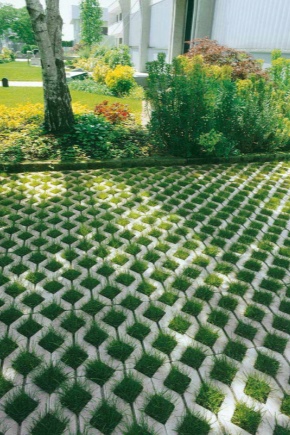
Any owner of a country house dreams of a beautiful local area. The aesthetics of the landscape is largely determined by the correct approach to its design. Today, a lawn grate is increasingly used for this purpose. This building material is in high demand among buyers and has a number of features. This article will acquaint readers with its purpose, outline the pros and cons, tell you what it is made of, how it is laid and chosen.
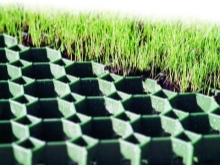
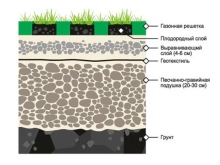
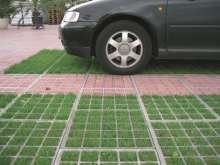
What are they for?
Lawn grates are fabrics of cellular modules. They are connected to each other by means of locking elements. These products are used in order to obtain a monolithic frame for sowing lawn grass. Often, watering and precipitation prevent a beautiful lawn from being obtained.
Lattices are needed in order to hold the root system of the relief areas of the soil. They are a means of preventing destruction of the lawn and on flat terrain. Thanks to them, it is possible to create ideal pedestrian and playground green areas, as well as the so-called eco-parking. Modular cells perfectly allow moisture from the outside, they do not interfere with the growth of the grass.
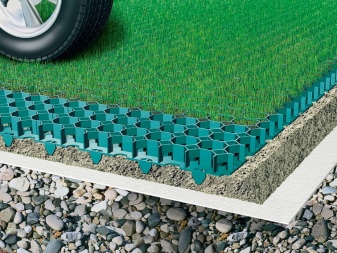
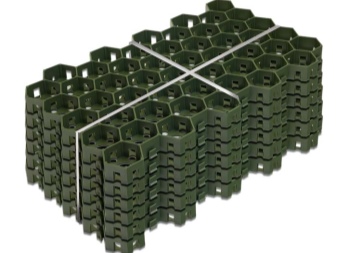
The key task of the products is to protect the lawn grass from trampling and damage under the wheels of the vehicle. In addition, based on the purpose of the coatings, often cellular material after laying is covered not only with fertile soil, but also with gravel. In the second case, special paths are created with the help of a lawn grate.
Where is it used?
Lawn grates are considered a versatile building material. To date, they have found application in the creation of:
- sports grounds;
- park zones;
- golf courses;
- eco-parking on the lawn;
- garden paths in the country;
- children's playgrounds.
In addition, lawn grates are widely used by landscape designers. With the help of modular cellular structures, they create alpine slides, as well as flower beds of the most unexpected shapes. Depending on the type, building material is used to create paving slabs, as a covering for a terrace or even a green recreation area.
Lawn gratings are also used in the construction of temporary sites for holding festive events in the open air. In addition, the material is used in the design of summer arbors, as well as decking on the roof of private country-type buildings.
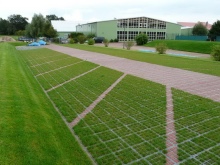

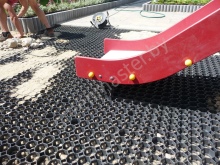
Lawn grates are indispensable for creating bike paths and parking lots. They are used by private developers and large utility companies.
Advantages and disadvantages
Lawn grates have many advantages. For example, they:
- considered the best protection for lawn grass;
- are a means of preventing soil sliding and erosion;
- prevent mechanical destruction and deformation of the lawn;
- contribute to the creation of optimal conditions for the growth of grass;
- characterized by ease of installation and durability;
- increase the aesthetic qualities of the lawn, are not visible after overgrowing;
- allow styling in the form of various geometric shapes;
- do not emit toxic substances;
- help to strengthen the soil;
- maintain proper air circulation in the soil;
- visually level the lawn area.
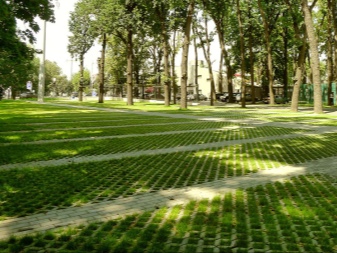
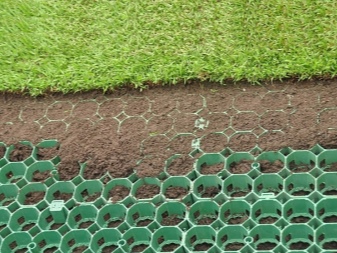
The undoubted advantage of the material is that a set of special tools is not required for its laying.The material is frost-resistant and easy to maintain, while one of the frame types can be recycled after dismantling. Thanks to the use of trellises, it is possible to grow a dense grass cover. However, along with the advantages, lawn grates have several disadvantages.
For example, if the lawn grates were used as a parking lot, to restore the plants after passing the wheels of the transport, you have to cut the grass to the height of the modular boards... In addition, the laying of the material requires careful preparation of the substrate. By itself, it is simple, but if the modules are laid on an unprepared base, due to atmospheric precipitation and the weight of the transport, the coating will shrink.
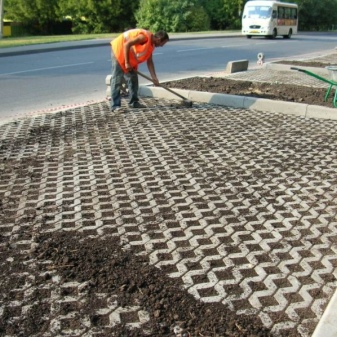

Grass filters for lawn grass have to be selected taking into account the weight load that they must withstand. The varieties are by no means universal in terms of weight, the load is distributed due to the walls of the lattice modules. The disadvantage is the likelihood of cutting off the sprouts in certain varieties when driving through the lattice of transport.
As for the use of gratings as a parking lot, there are some nuances here. For example, the car should not be allowed to stand in one place. If you do not put it in different places, the grass under it will turn yellow and wither very quickly. It will not look attractive, because the grass needs constant access to natural light.
Another disadvantage of parking lots created with the help of grilles is the complexity of clearing the cells from technical fluids from a car.
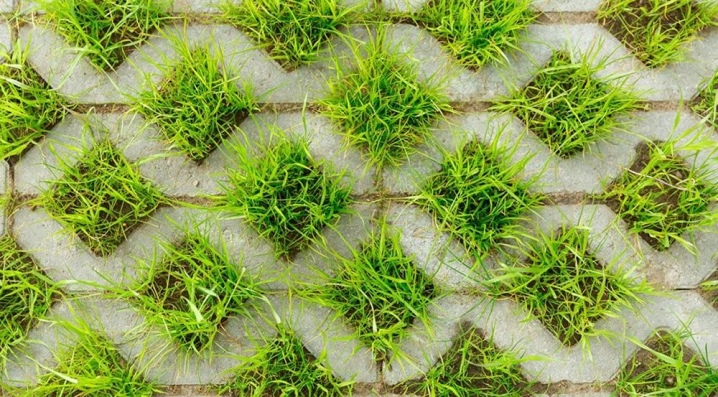
If they hit the ground, they will kill plants, poisoning the ground. In order to carry out high-quality cleaning, in this case, you will have to think about partial dismantling of the coating.
Types and materials
Conventionally, the entire range of lawn grates can be divided into 2 types: light and heavy. Products of the second line are designed for significant weight loads, they are often used to strengthen slopes and embankments.
Today, high-strength concrete and plastic are used in the production of lawn gratings. Each type of material is characterized by its practical performance characteristics, which is why it is selected based on the tasks set. Depending on the calculation of the permissible load on the grid and its material, they can be equipped with additional stiffeners.

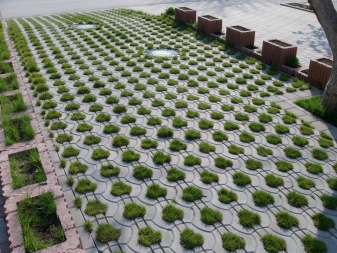
Concrete
Concrete products appeared earlier than their plastic counterparts. Today they are used less often, although their performance is quite high. They are quite durable, designed for high weight loads, which makes them perfect for parking lots of trucks. Such grilles are inexpensive, easy to install and have a long service life. When using them, waterlogging of the lawn is excluded, and therefore there will be no dirt on it even after rain.

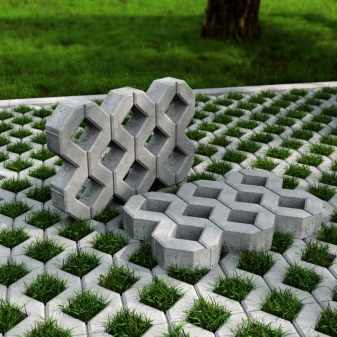
Various communications (sewage or water supply) can be carried out under such gratings. The material itself is distinguished by its high weight; for its delivery to the installation site, it is required to order a special transport. In addition, the concrete gratings are massive, their walls are thick. In view of this, they almost always look through the grass. Such blocks are made by casting or vibrocompression.
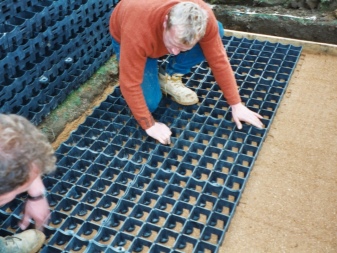
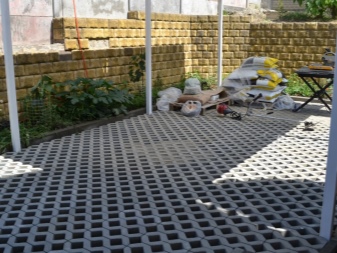
Plastic
Plastic products have a number of advantages over their concrete counterparts. Their weight is significantly less, while they are strong enough and provide for quick connection to each other. Their service life can be up to 25 years or more; when buying them, no special transport is needed. The disadvantage of the material is the high price, which is charged not per square meter, but each cell.
Flexible counterparts are designed for weight up to 120 tons per sq. m, they are used in areas such as strengthening slopes, creating lawns in horse riding arenas and grounds in equestrian sports clubs. Polymer-sand parking needs high strength options.Heavy-duty grates are capable of supporting heavy weights and reinforcing moving ground.


Colors
The color of the lawn grates depends on the type of material used. Concrete products have a natural gray tint. Plastic options are created in two colors: green and black. In this case, the green color can vary in brightness. This allows you to select the option with the greatest resemblance to grass, eliminating the likelihood of material peeking through the growing greenery. Less commonly, a dark brown grille is found on sale.
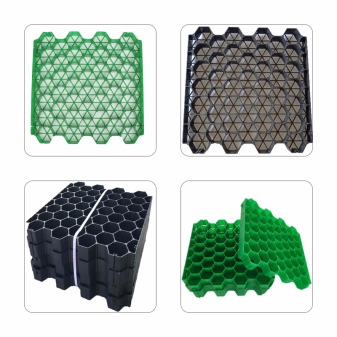
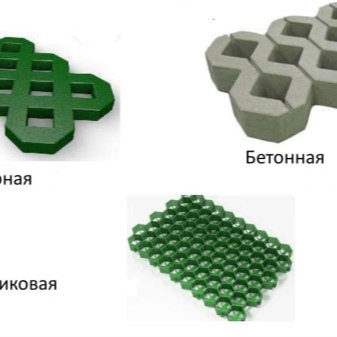
Sizes and shapes of cells
Snap-on lawn grating modules can vary in size and shape. The structure of a single module can be based on a geometric figure with several angles. As a rule, these are honeycombs, rhombuses, as well as squares with a minimum height of at least 4-5 cm. In addition, the shape of the modules can be round.
but if the shape of concrete products can limit the design of the landscape, then the purchase of plastic modules allows you to create the most unusual types of decoration of the local area... The standard dimensions of concrete gratings are 600x400x100 mm. The parameters of plastic models are 600x800x30 630x430x380, 385x385x500 mm.
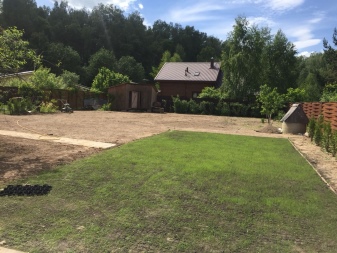
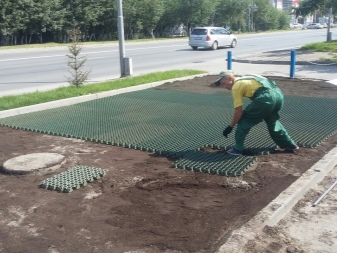
How to stack?
Laying lawn gratings does not require any special construction skills, and therefore anyone can do the installation with their own hands. The laying technology will consist of several successive steps. Consider how to lay the plastic grill yourself.
- Initially, the amount of material is calculated and raw materials are purchased based on the purpose of the future lawn.
- Mark out the area for the installation of the lattice.
- A soil layer (up to 28 cm) is removed from the marked area, taking into account the thickness of the gravel cushion (10-20 cm), the leveling layer (3 cm), the lawn grate (5 cm).
- After removing the soil layer, the boundaries of the dug area are strengthened, the bottom is tamped.
- A pillow of a mixture of sand and gravel is poured onto the ground. The use of sand will exclude the perforation of crushed stone or gravel during operation.
- Geotextiles are laid on top of the cushion, which will prevent the growth of weeds, exclude the sinking of the soil and support the drainage of the lawn.
- A leveling layer of sand is poured over the geotextile.
- They start assembling the connecting elements of the lattice, assemble them into a monolithic canvas.
- If somewhere the lattice module does not fit into the base entirely, trimming is performed.
- The cellular fabric of the desired shape is placed on top of the leveling sand layer.
- The canvas is covered with soil up to the upper boundaries of the plastic cells.
- The site is watered, due to which the soil will settle somewhat.
- After that, you can start sowing lawn grass or roll out the finished lawn.
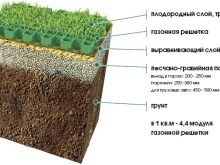
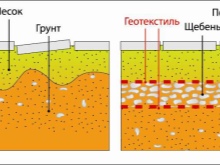
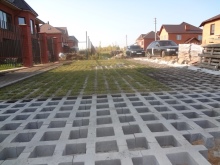
Assembling the modules is easy: they are usually stacked from left to right. Trimming the modules is simple and does not take a lot of effort. Due to the simplicity of working with the material, it is possible to create not only straight or linear shapes of paths and lawns from it. It is quite possible to create curvilinear and even fantasy forms from this material, which will allow you to refine the local area and decorate the landscape.
For example, thanks to this feature, you can put a grate around the hatch, along the house, from the gazebo to the house. Also, using this building material, you can limit flower beds and triangular shapes. The styling process is quite fun and allows you to show maximum imagination, especially when a person with taste takes up the task. Any summer resident can lay a plastic lattice.
Lawn installation options vary. For example, you can combine a lawn with paving slabs, making paths on both sides of the lawn or forming flower beds.
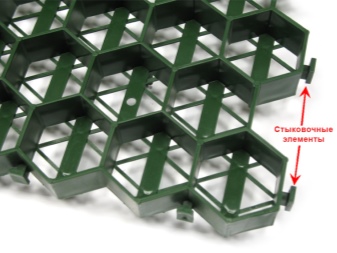
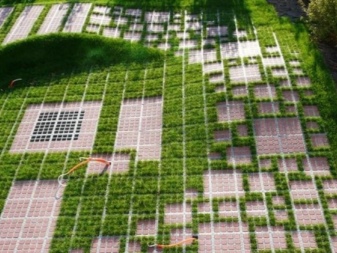
You can create various compositions using lattices, selecting various plants to decorate the landscape.
Selection recommendations
Despite the fact that in the store the seller will find a lot of advantages for each material, you should not buy the first thing that is offered to you. Important criteria for buying a lawn grill are 2 indicators: size and load. In this case, one cannot ignore the form.
Usually, concrete products of different shapes mean different weight loads... Concrete honeycomb grates can withstand a weight of up to 20 tons. They are bought for lawns and parking when arranging sidewalks, parking lots for cars, children's playgrounds. Square-shaped counterparts carry a weight of up to 400 tons, they are designed to be installed in places with the most intensive traffic.
In order to purchase the product correctly, it is important to take into account other nuances. For example, it is important to take into account the safety factor, adding 30-40% to the maximum possible weight per 1 sq. m of lattice specified by the seller. If the grating is needed not for parking, but for lawns, it is enough to add 10%. If you want to buy polymer products, you should pay attention to the composition of the material.
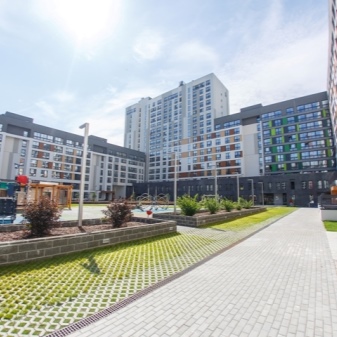

You cannot buy cheap types of plastic: the cheapness of the product is explained by the inclusion of various impurities in the composition. As a result, such a lawn will not last long, it will quickly break. The parking geogrid must be made of 100% polyethylene. The weight of the material should be 6 kg per 1 sq. m, the walls should be 5 mm thick.
In order for the fastening to be reliable and not to create unforeseen situations, the "lock-groove" system is chosen. In order not to worry about the temperature drop, it is worth purchasing options with temperature cells. At the same time, they pay attention to the cost. A good plastic frame will not be cheap, it doesn’t sell for a promotion, it doesn’t participate in a sale.
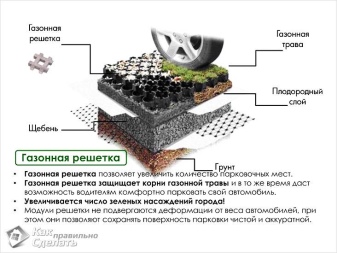
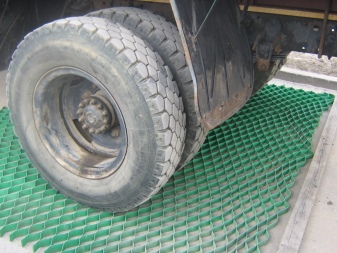
If you plan to buy building material for arranging a garden plot, they take options for building a lawn designed for an average weight. To make the structure last longer, the type of attachment and temperature cells are selected, as in the previous version. Sometimes it is necessary to create a lawn with different operational properties (for example, for a garden, a pedestrian zone and a parking lot). In this case, they try to choose a material that will withstand both medium and heavy weight loads.
For example, you can purchase a concrete type of lattice or an analogue of a rigid polymer... The material must withstand at least 12 tons per 1 sq. m. Maximum it must withstand up to 25 tons per square meter. m. If the choice fell on concrete products, it is preferable to take the one obtained by vibrocompression. It is stronger and more durable, withstands any weight load.
For information on how to mount a lawn grate, see the next video.



































































The comment was sent successfully.